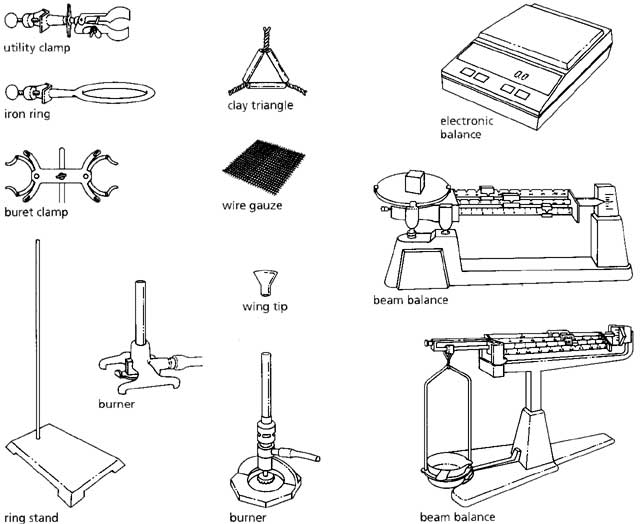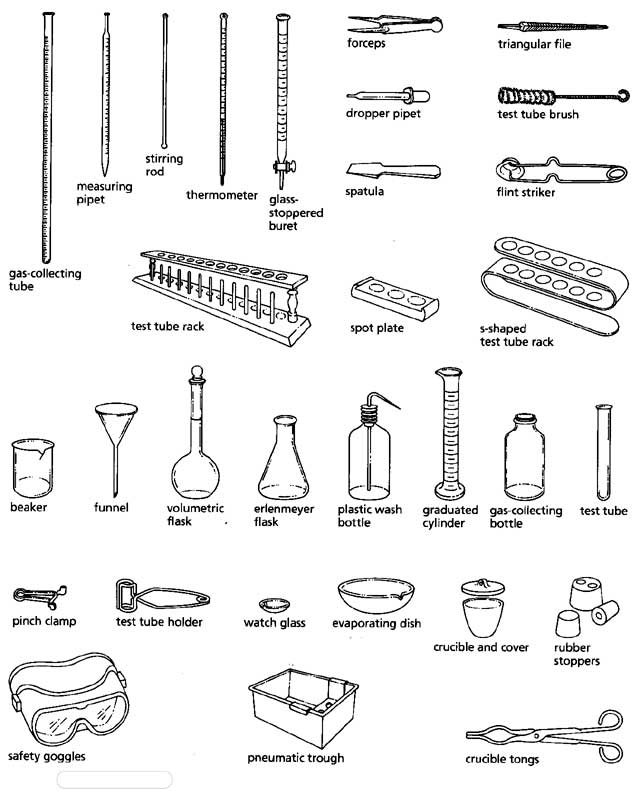Background:
In the chemistry laboratory, you will be using equipment , handling materials,
and performing certain unfimiliar tasks. The purpose of this lab is to introduce
you to the equipment and to describe some of the skills you will be required
to use in this course. A few of the "does" and "dont's" necessary for safe and effective laboratory work will be explained in class.
Procedures:
1. Print a copy of this page and memorize the purpose and identity of piece
of equipment represented here.
2. Print a copy of the Safety rules and keep it in your folder. Memorize
ALL the rules.
Lab Equipment:


Lab
Safety:
Chemistry is a laboratory science. In the laboratory, you become actively
involved in the process of investigation and will develop an appreciation
of the scientific method of inquiry. As a result of some laboratory activities,
you will 'discover" important chemical concepts before they are introduced
in the classroom. In other activities, concepts learned in class will be
reinforced or clarified.
Following
General Safety Guidelines:
1. Be prepared to work when you arrive at the laboratory. If instructed
to do so by your teacher, familiarize yourself with the lab procedures before
beginning the lab.
2. Perform only those lab activities assigned by your teacher. Never do
anything in the laboratory that is not called for in the laboratory procedure
or by your teacher.
3. Work areas should be kept ciean and tidy at all times. Only lab manuals
and notebooks should be brought to the work area. Other books, purses, briefcases,
etc. should be left at your desk or placed in a designated storage area.
4. Clothing should be appropriate for working in the lab. Jackets, ties,
and other loose garments should be removed. Long sleeves should be rolled
up or secured in some manner.
5. Long hair should be tied back or covered, especially in the vicinity
of an open flame.
6. Jewelry that might present a safety hazard, such as dangling necklaces,
chains, medallions, or bracelets, should not be worn in the lab.
7. Follow all instructions, both written and oral, carefully.
8. Safety goggles and a lab coat or apron should be worn at all times.
9. Set up apparatus as described in the lab activity or by your teacher.
Never use makeshift arrangements.
10. Always use the prescribed instrument (tongs, test-tube holder, forceps,
etc.) for handling apparatus or equipment.
ll. Keep all combustible materials away from open flames.
12. Never touch or taste any substance in the lab unless instructed to do
so by your teacher.
13. Never put your face near the mouth of a container that is holding chemicals.
14. When testing for odors, use a waffing motion to direct the odors to
your nose. Never smell any chemical unless instructed to do so.
15. Any activity involving poisonous vapors should be conducted in the fume
hood.
16. Dispose of waste materials as instructed by your teacher.
17. Clean up all spills immediately.
18. Clean and wipe dry all work surfaces at the end of class. Wash your
hands thoroughly.
19. Know the location of emergency equipment (first-aid kit, fire extinguisher,
fire shower, fire blanket, etc.) and how to use them.
20. Report all accidents to the teacher immediately.
Handling
Chemicals:
21. Read and double-check labels on reagent bottles before removing any
reagent. Take only as much reagent as you need.
22. Do not return unused reagent to stock bottles.
23. When transferring chemical reagents from one container to another, hold
the containers out away from your body.
24. When mixing an acid and water, always add the acid to the water.
25. Avoid touching chemicals with your hands. If chemicals do come in contact
with your hands, wash them immediately.
Handling
Glassware:
26. Glass tubing, especially long pieces, should be carried in a vertical
position to minimize the likelihood of breakage and to avoid stabbing anyone.
27. Never handle broken glass with your bare hands. Use a brush and dustpan
to clean up broken glass. Dispose of the glass as directed by your teacher.
28. Always lubricate a piece of glassware (tubing, thistle tubes, thermometers,
etc.) with water or glycerine before attempting to insert it in a stopper.
29. Never apply force when inserting or removing glassware from a stopper.
Use a twisting motion. If a piece of glassware becomes "frozen" in a stopper, take it to your teacher.
30. Do not place hot glassware directly on the lab table. Always use an
insulating pad of some sort.
31. Allow plenty of time for hot glass to cool before touching it. Hot glass
can cause painful burns. (Remember: Hot glass looks cool.)
Heating
Substances:
32. Exercise extreme caution when using a gas burner. Keep your head and
clothing away from the flame.
33. Always turn the burner off when it is not in use.
34. Do not bring any substance into contact with a flame unless instructed
to do so.
35. Never heat anything without being instructed to do so.
36. Never look into a container that is being heated.
37. Never heat a closed container.
38. When heating a substance in a test tube, make sure that the mouth of
the tube is not pointed at yourself or anyone else.
39. Never leave unattended anything that is being heated or that is visibly
reacting.